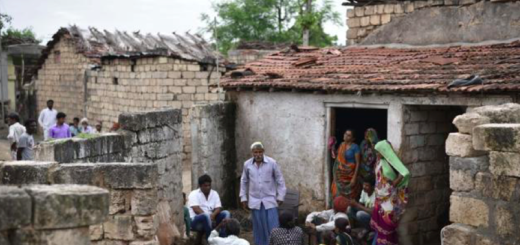India’s Untouchables – Gwendolyn Simpson Chabrier

 Hypocrisies of caste system – Timely reminder to Indians: In THE ASIAN AGE, PATRALEKHA CHATTERJEE, Apr 21, 2017
Hypocrisies of caste system – Timely reminder to Indians: In THE ASIAN AGE, PATRALEKHA CHATTERJEE, Apr 21, 2017
The book comes across as one about caste as seen through a Western lens. Grove Press, pp. 272, Rs 1,088
(Note: This article is a book review on the 267-page “India’s Untouchables” by Dr Gwendolyn Simpson Chabrier who sees and judges things through her western eyes.
The central point she highlights is that women in India were totally free from all shackles of Caste system till the advent of Manu and were equal to men in all spheres. Even after Manu Indian women continued and still continue to be equal to men and acceptable and not “untouchable” in the matter of sex.
She writes: “No one practises untouchability when it comes to sex.” This underlines and high lights the corrosive hypocrisy of the caste-based order. This is applicable equally to racism practiced in the US, where the blacks and coloured are acceptable and touchable to whites for sex with no let or hindrance.
 So sex practices in both countries prove beyond any shadow of doubt that all the loud talk about racism and casteism is the product of vested interests of the men folk: their glaring hypocrisy and nothing more. james kottoor, editor)
So sex practices in both countries prove beyond any shadow of doubt that all the loud talk about racism and casteism is the product of vested interests of the men folk: their glaring hypocrisy and nothing more. james kottoor, editor)
It is not clear who the intended reader of Dr Gwendolyn Simpson Chabrier’s 267-page book India’s Untouchables may be. Dr Chabrier has taught literature at universities in New York and Paris and has written about William Faulkner and Norman Mailer in the past. She has also authored a novel about Myanmar called Asian Destiny and another novel, Behind the Barbed Wire, about the Holocaust.
Bookshelves groan under the weight of books written about the horrors of the Holocaust. They may soon start groaning under the weight of books written about India by anyone who has had any connection with this country and some who have just had access to libraries and secondary material.
The author has clearly spent an enormous of time reading about India’s caste system. The bibliography runs into almost 15 pages. This is in addition to the notes and references at the end of each of the six chapters.
For many Indians, much of what Dr Chabrier says would be familiar. Caste remains one of those subjects that the argumentative Indian can argue endlessly about. In Narendra Modi’s India, we are told caste is becoming less relevant and subsumed to development with a Hindutva packaging. But Uttar Pradesh’s new chief minister and Bharatiya Janata Party’s stormy petrel Yogi Adityanath is on record saying that while he does not believe in casteism, he does not see anything wrong with caste being the organising principle of society. This essentially boils down to saying that everyone should know his/her place. That is the central message of caste. Those who stand to lose with this organising principle are those at the bottom of the hierarchy and who face the brunt of oppression by those above.
Dr Chabrier catalogues a lot of the information that is available about various aspects of caste — the pernicious system, it origins, etc., the social reformers and politicians in India who tried to turn this system upside down, the untouchable men, the untouchable women, the untouchable children and finally untouchables and Indian literature.
Given the way the information is presented, the book does come across as one about caste as seen through a Western lens. It provides a lot of information to non-Indian readers who may know little about the subject and can be used as a rapid reader by Indians who know something about the subject but would like to go deeper.
I found the chapter on “The Untouchable Women” one of the more interesting parts of the book. Dr Chabrier’s style is text-bookish, but there are sections in which India’s Untouchables comes alive as in the segment about Manu Smriti and women. She lists the various ways in which women were sought to be debased while they were struggling to regain the respect and equality they used to have in the early Vedic era.
While pointing out that the untouchable and Sudra women were the most vulnerable, “as they were positioned at the lowest level of the social, economic and religious ladder,” the author rightly draws attention to the fact that prior to the time of Manu, not only were women in this country free to choose their husbands or to remarry if widowed, they also held positions of high respect in the intellectual and social spheres. The chapter talks about the various phases of India’s feminist movement and situates the formation of the National Federation of Dalit Women in 1995 in that context. There are references to other Dalit women’s organisations too.
One sentence that leapt out in this chapter is a quote from a woman activist who observes, “No one practises untouchability when it comes to sex,” underlining the corrosive hypocrisy of the caste-based order.
In her conclusion, the author makes a point worth recognising. “Since the 1991 economic reforms were implemented, India has become an international player. Despite the country’s poverty, the Indian economy has furthermore demonstrated a steady growth. Yet once again, caste has still remained a hindrance for India in reaching its full economic potential. This is the result of India’s fundamental belief in inequality.”
Many Indians that I know would froth and fume reading that. Caste may not be a big factor in the lives of many people we know and mix with in metropolitan India. But despite all the laws and rhetoric, it remains a dark, unimaginably grim reality in huge swathes of the country. We know much of what Dr Chabrier tells us. Till we collectively reject caste as an organising principle of the social order, the slogan of Sabka Saath Sabka Vikas can’t become a reality for millions.
















